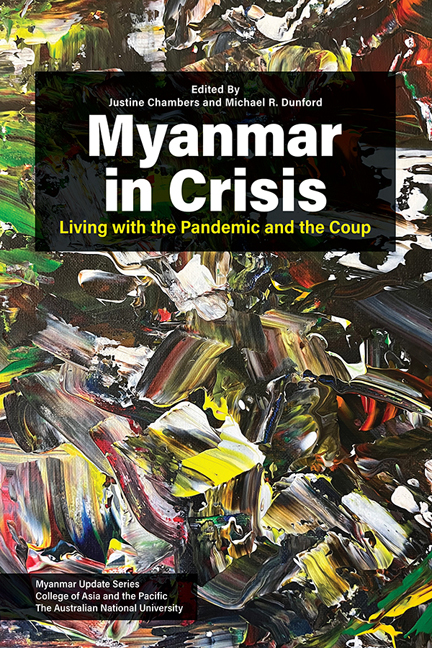4 - Covid, Coup and Prisons: Exploring Crisis as Context in Myanmar
Published online by Cambridge University Press: 01 March 2024
Summary
This chapter analyses the compounding effects of the COVID-19 health crisis and the political crisis of the February 2021 military coup in the context of Myanmar prisons. We want to start off this analysis by describing a particular photo. We suppose most fellow researchers and other people, who try to follow and understand both COVID-19 and the coup have been inundated with intense and disturbing photos and accounts of suffering in Myanmar. Unsurprisingly, we did so too in preparation for writing this chapter. One photo stood out for us. It is a photo of a young man by the name of Ko Manzar Myay Mon, an activist from Chang-U township in Sagaing region, who was arrested and detained on 8 June 2021. The photo, which was posted on Twitter, among others by the UN Special Rapporteur on Myanmar,2 shows Ko Manzar Myay Mon sitting crossed legged with his hands tied behind his back. One sees the boot and the camouflaged arm of a security officer next to him, who seems to pull his head back for the camera. The young man's face is bruised but expressionless, his t-shirt torn. Accounts of the injuries and torture that Ko Manzar Myay Mon was victim of after his arrest caused widespread condemnation3 and his trial is still pending as we write this chapter. Yet, in direct relation to the issue in focus here something else also stands out as particularly absurd and deeply disturbing. His captors have blindfolded him with a disposable facemask, which is lifted off his mouth to cover his eyes, strings around the ears still attached.
The photo documents as well as symbolizes — in a basic and brute way — how detention and COVID-19 collide in Myanmar today. The facemask over Ko Manzar Myay Mon's eyes shows how the agents of the junta menacingly distort and disregard the need to respond with minimal care and caution to the threat of COVID-19. Most apparently, placing the facemask over Ko Manzar Myay Mon's eyes shows a disregard for basic health safeguards. At a deeper level, this seemingly banal act changes a formally protective health technology into a tool of coercion and connotes the junta's readiness to distort the pandemic response and turn the threat of COVID-19 against the public.
- Type
- Chapter
- Information
- Myanmar in CrisisLiving with the Pandemic and the Coup, pp. 69 - 92Publisher: ISEAS–Yusof Ishak InstitutePrint publication year: 2023



